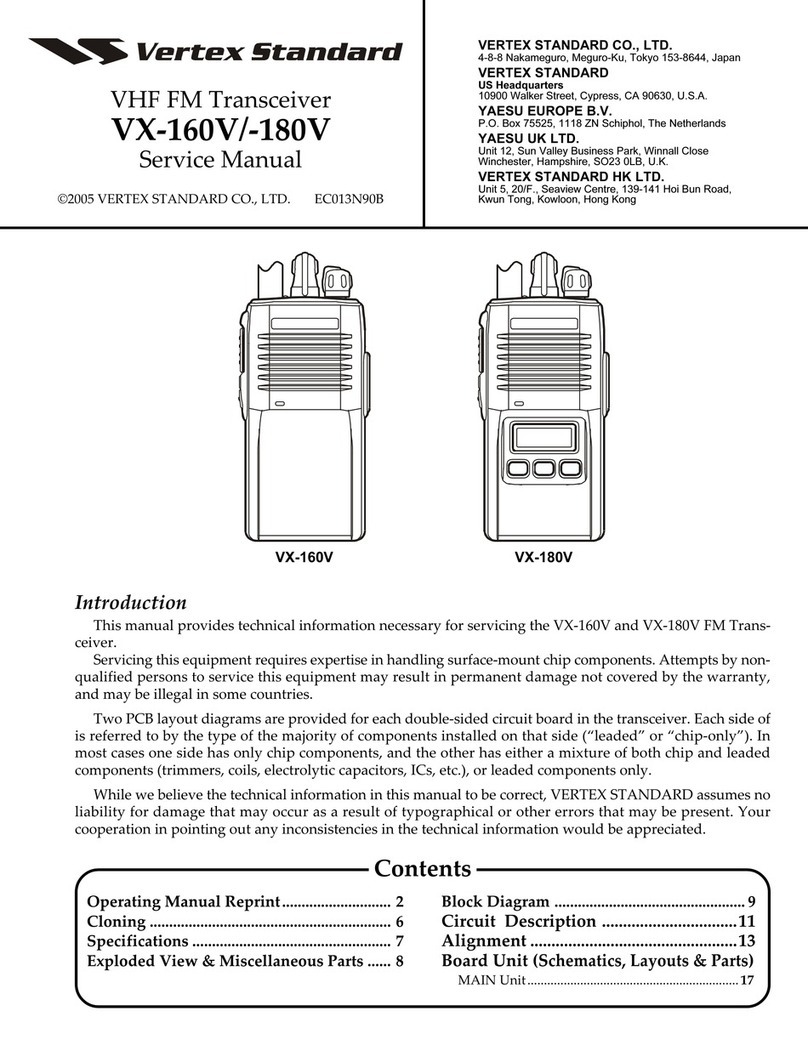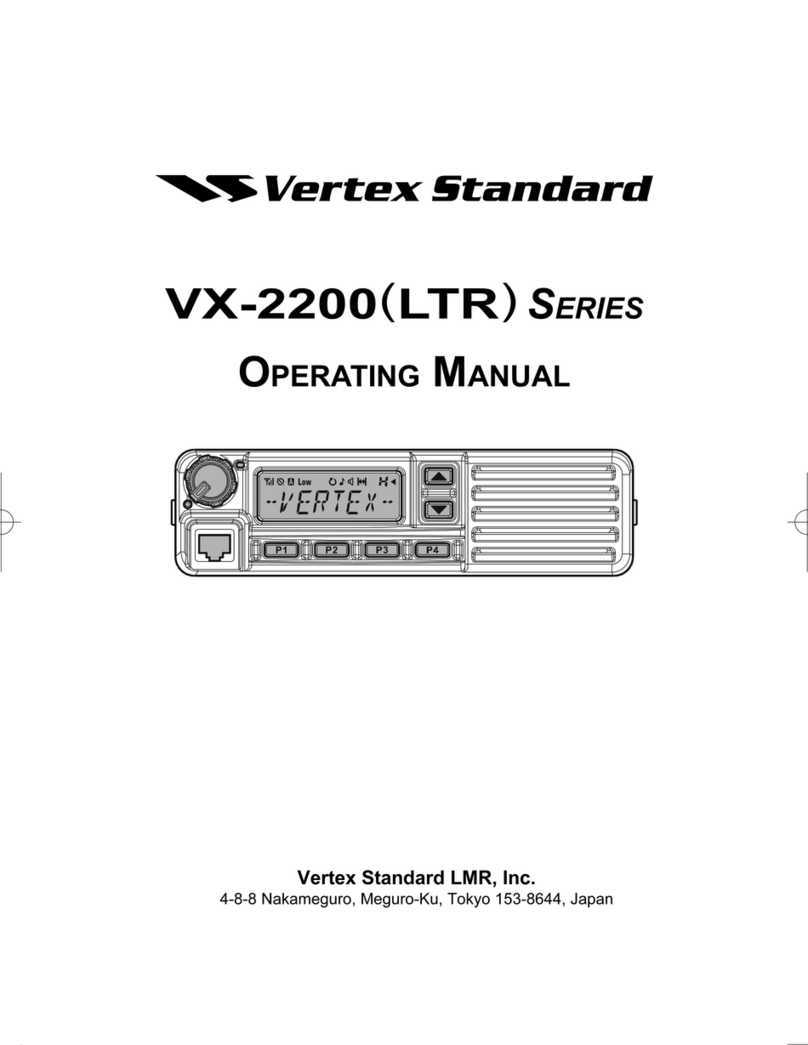
7FTM-10R/E Technical Supplement
Circuit Description
RECEPTION
VHF Reception
The incoming VHF signal is passed through the low-pass
filter network, antenna switching diodes and low-pass fil-
ter network to the RF amplifier Q1009 (3SK296ZQ). The
amplified RF signal is passed through the band-pass fil-
ter again by varactor-tuned resonators L1024, L1025, and
D1026 (HVC365) then applied to the 1st mixer Q1010
(3SK296ZQ) along with the first local oscillator signal
from the PLL circuit.
The first local oscillator signal, between 191.25 MHz and
195.25 MHz, is generated by the VHF VCO, which con-
sists of Q1309 (2SC5006) and varactor diodes D1310
(HVC365), D1311 (HSC277TRF), and D1312 (HVC365),
according to the receiving frequency.
UHF Reception
The incoming UHF signal is passed through the low-pass
filter network, antenna switching diodes and Low-pass
filter network to the RF amplifier Q1011 (3SK296ZQ). The
amplified RF signal is passed through the band-pass fil-
ter varactor-tuned resonators D1031 and D1032, and
D1033 (all HVC350B) then applied to the 1st mixer Q1013
(3SK296ZQ) along with the first local signal from the PLL
circuit.
The first local oscillator signal is generated between 382.75
MHz and 402.75 MHz by the UHF VCO, which consists
of Q1313 (3SK296ZQ) and varactor diodes D1314
(HSC277TRF), D1315 and D1316 (both HVC375B), ac-
cording to the receiving frequency.
IF and Audio Circuits
The 47.25 MHz first IF signal is applied to the monolithic
crystal filters XF1401 and XF1402 which strip away un-
wanted mixer products, and the IF signal is applied to
the first IF amplifier Q1407 (2SC4915). The amplified first
IF signal is then delivered to the FM IF subsystem IC
Q1408 (NJM2552V-TE1), which contains the second mix-
er, limiter amplifier, noise amplifier, and FM detector.
The second local oscillator signal is generated by the 46.8
MHz crystal X1301 and Q1403 (2SC4915), produces the
450 KHz second IF signal when mixed with the first IF
signal within Q1408 (NJM2552V-TE1) it produces the 450
KHz second IF signal..
The 450 KHz second IF signal is applied to the ceramic
filter CF1402, which strips away unwanted mixer prod-
ucts. The limiter amplifier within Q1408 (NJM2552V-TE1)
removes the amplitude variations of the 450 KHz IF sig-
nal. Speech detection is within Q1408 and the ceramic
discriminator CD1401.
The detected audio passes through the de-emphasis net-
work, a low-pass filter consisting of Q1419 (LM2902PWR)
and associated circuitry, and then a high-pass filter con-
sisting of Q1420 (LM2904PWR) and associated circuitry.
The filtered audio signal is passed through the audio vol-
ume control IC Q1511 (M61524FP-DF0G) that adjusts the
audio sensitivity to compensate for audio level variations.
When the internal speaker is selected, the audio signal is
amplified by Q1602 (TDA1519CTH) then applied to the
internal loudspeaker. When the external speaker is select-
ed, the audio signal is amplified by Q1602 (TDA1519CTH),
and then passed through the EXT SP jack to the external
loudspeaker.
Transmit Signal Path
The speech signal from the microphone passes through
the MIC jack J1604 to AF amplifier Q1508 (LM2904PWR)
on the MAIN unit. The amplified speech signal ampli-
tude is limited by Q1509 (M62429FP 780C). The speech
signal passes through buffer amplifier Q1501
(LM2902PWR) and the low-pass filter network section of
Q1501 (LM2902PWR).
VHF Transmit Signal Path
The adjusted speech signal from Q1501 (LM2902PWR)
frequency modulates the VHF transmitting VCO, made
up of Q1309 (2SC5006) and D1312 (HVC350B).
The modulated transmit signal passes through buffer
amplifier Q1308, and Q1307 (both HSC277TRF).
The filtered transmit signal is applied to the Pre-Drive
amplifier Q1003 (2SK2596BXTL) and Drive amplifier
Q1002 (RD07MVS1), and then is finally amplified by Pow-
er amplifier Q1001 (RD70HVF1) up to 50 Watts. This three
stage power amplifier's gain is controlled by the APC cir-
cuit.
The 50 Watt RF signal passes through the high-pass filter
and low-pass filter networks, the antenna switch D1007
and D1008 (both L709CER), and another low-pass filter
network, The signal is then delivered to the ANT jack.
UHF Transmit Signal Path
The adjusted speech signal from Q1501 (LM2902PWR)
frequency modulates the UHF transmitting VFO, made
up of Q1313 (2SC5006-T1) and D1316 (HVC375B).
The modulated transmit signal passes through buffer
amplifier Q1312, Q1310 and Q1311 (all 2SC5006).
The filtered transmit signal is applied to the Pre-Drive
amplifier Q1003 (2SK2596BXTL) and Drive amplifier
Q1002 (RD07MVS1), and then finally is amplified by Pow-
er amplifier Q1001 (RD70HVF1) up to 40 Watts. This three
































